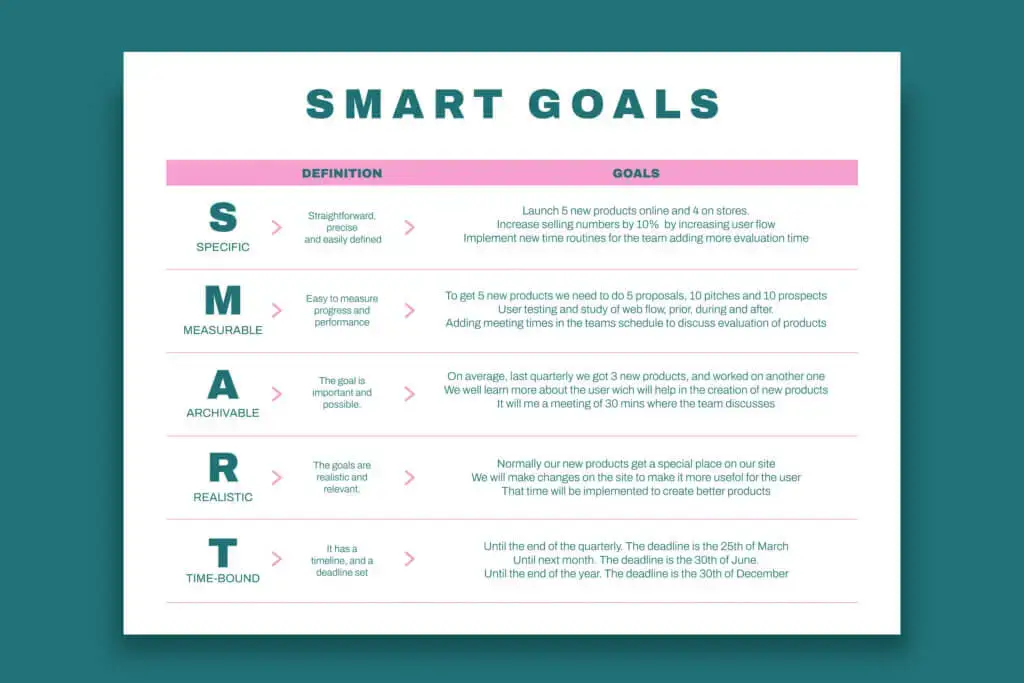Introduction
SMART goals and objectives are important in personal and professional development because setting goals is akin to charting a course toward success.
You see not all goals are created equal. Some may be vague, and lacking direction, while others might be unrealistic or unattainable. But SMART goals and objectives ensure a greater chance of success.
Let’s take a look.
What are SMART Goals and Objectives?
SMART is an acronym that stands for
- Specific
- Measurable
- Achievable
- Relevant, and
- Time-bound.
When applied to goal-setting, it provides a framework to ensure that objectives are clear, quantifiable, realistic, and anchored within a defined timeframe.
Each component of the SMART criteria serves a distinct purpose. Let’s look at them individually
Specific
The “specific” element in SMART objectives refers to the need to define goals and objectives in a clear and precise manner.
Specific objectives should detail what is to be accomplished, by whom, where, and when.
It is essential to identify exactly what needs to be done, as this helps to provide focus and direction, ensuring that all stakeholders are working towards the same end goal.
Specific objectives help to eliminate ambiguity and ensure that everyone working on the project understands what is expected of them.
Example
For example, instead of setting a vague goal like “increase sales” a specific goal would be “increase sales for in-store dog related products across all branches within the UK .”
Measurable
The measurable element of a SMART objective is crucial as it measures progress, enables the determination of success, and determines if the objective has been accomplished or not.
It is essential to have a way of tracking progress to determine if the objective has been accomplished or not, so having this element, enables individuals to see how far they have come and what adjustments need to be made.
Example
Adding the measurable element to the previous example we would say
“increase sales for in-store dog-related pet products across all branches within the UK by 10% compared to the previous quarter.”
Adding the percentage allows us to know what we are aiming for (a 10% increase) and allows us to take a baseline of sales and track the climb towards the 10% increase.
Achievable
Now is the reality check. Is your goal or objective achievable?
The achievable element of a smart objective refers to setting a goal that is reasonable and can be attained with your available resources and knowledge.
It is important to ensure that the objective is challenging yet achievable, as underwhelming objectives can lead to complacency. When targets are achievable, individuals are more likely to stay motivated and committed to their goals.
However, setting unrealistic targets can lead to frustration and disappointment if they are not achieved.
By setting targets that are within reach, individuals can prioritise tasks effectively and allocate resources efficiently.
Relevant
Goals should align with broader objectives and be pertinent to the individual’s aspirations or the organisation’s mission. Ensuring relevance fosters commitment and maintains momentum toward desired outcomes.
A relevant goal contributes to the individual’s or organisation’s mission, vision, or values. It takes into account the current circumstances and priorities, ensuring that efforts are focused on outcomes that matter.
For instance, if an organisation aims to reduce its carbon footprint, setting relevant goals could involve implementing sustainable practices or reducing energy consumption.
The relevance of an objective can be assessed by asking whether it supports organisational strategies or is needed to achieve other objectives. It is essential to make sure that the objective contributes to the growth of an organisation, and is significant enough to make a difference.
Time-bound
Goals should be anchored within a specific timeframe, providing a sense of urgency and accountability.
Establishing deadlines creates a sense of focus and helps prioritise tasks effectively. It also helps create a sense of focus and helps prevent procrastination.
By including a timetable, it also allows for progress tracking and adjustments to be made if necessary. And by setting a particular target date, it encourages individuals or organisations to remain focused and aligned with their objectives.
Furthermore, establishing a time limit ensures accountability and improves effectiveness overall, as it creates a specific end goal that drives performance and promotes success.
For example, instead of saying “launch a new product,” a time-bound goal would be “launch a new product by the end of the second quarter.”
Steps to Take and Tips for Effective Goal Setting
Effective goal setting is a structured process that requires careful planning and execution.
Here are steps to take and tips to ensure success:
Step One: Reflect on Your Values and Priorities
Before setting goals, take time to reflect on your values, passions, and long-term aspirations. Aligning goals with your core values ensures that they are meaningful and motivating.
Look at your vision and mission statement. The vision and mission will cascade down into your SMART goals and objectives.
Related Reading: Easy Vision and Mission Statement Secrets for 2024
Step Two: Be Specific and Clear
Set clear and specific goals that define what you want to achieve, why it’s important, and how you plan to accomplish it.
Use the SMART criteria (Specific, Measurable, Achievable, Relevant, Time-bound) to ensure clarity and focus.
Step Three: Break Down Goals into Manageable Steps
Divide larger goals into smaller, more manageable tasks or milestones.
Breaking down goals into actionable steps makes them less daunting and increases the likelihood of success.
Breaking Down Larger Goals into Manageable Tasks
Here are some strategies for doing so:
Identify Key Milestones: Break down larger goals into smaller, more manageable milestones or checkpoints.
Each milestone should represent a significant step toward achieving the overall goal and provide a sense of progress and accomplishment.
Prioritise Tasks: Prioritise tasks based on their importance and urgency.
Focus on completing high-priority tasks that contribute directly to the achievement of the larger goal, while also considering dependencies and constraints.
Set Deadlines: Establish deadlines for completing each task or milestone.
Deadlines create a sense of urgency and accountability, motivating individuals to take action and avoid procrastination.
Monitor Progress: Regularly monitor progress toward each task or milestone to track performance and identify any potential obstacles or challenges.
Adjust timelines or strategies as needed to stay on course toward achieving the larger goal.
By breaking down larger goals into manageable tasks and setting realistic targets, individuals can maintain momentum, track progress effectively, and ultimately achieve success.
These strategies help individuals stay focused, motivated, and on track toward reaching their goals.
Step Four: Set Realistic and Achievable Targets
Be realistic about what you can accomplish within a given timeframe and with the resources available.
Setting achievable targets prevents overwhelm and fosters a sense of progress and accomplishment.
Step Five: Establish Deadlines and Timeframes
Set deadlines and timeframes for achieving each goal and milestone.
Time-bound goals create urgency and accountability, motivating you to take action and stay on track.
Step Six: Prioritise Tasks Effectively
Identify high-priority tasks that have the greatest impact on goal achievement and focus your efforts on those first.
Prioritising tasks ensures that you allocate your time and resources efficiently.
The Importance of Prioritising Tasks and Managing Time Effectively
Prioritising tasks and managing time effectively are essential skills for achieving goals within the specified deadlines.
Here’s why it’s important:
Optimising Resources: Effective time management ensures that resources such as time, energy, and effort are allocated efficiently to tasks that contribute to goal achievement.
By prioritising tasks based on their importance and urgency, individuals can optimise their resources and maximise productivity.
Reducing Stress and Overwhelm: Prioritising tasks helps individuals avoid feeling overwhelmed by breaking down goals into manageable steps.
By focusing on high-priority tasks first, individuals can reduce stress and maintain a sense of control over their workload.
Meeting Deadlines: Effective time management increases the likelihood of meeting deadlines by ensuring that tasks are completed in a timely manner.
By allocating sufficient time to each task and avoiding procrastination, individuals can stay on track toward achieving their goals within the specified timeframes.
Improving Decision-making: Prioritising tasks requires individuals to make informed decisions about how to allocate their time and resources.
By evaluating the importance and urgency of each task, individuals can make strategic decisions that support goal achievement and long-term success.
In summary, setting time-bound deadlines for goal achievement and prioritising tasks are essential components of effective goal management. By establishing clear deadlines, individuals create urgency and accountability, while effective time management ensures that tasks are completed efficiently and goals are achieved within the specified timeframes.
Step Seven: Track Your Progress
Regularly monitor your progress against predefined metrics and milestones.
Tracking progress allows you to stay accountable and make adjustments to your strategies as needed.
Methods for Measuring Progress and Success of SMART Goals and Objectives
There are various methods for measuring progress and success, depending on the nature of the objectives and the available resources.
Here are some common methods:
Quantitative Metrics
Quantitative metrics involve numerical measurements that provide clear and objective indicators of progress.
Examples include sales figures, revenue growth, customer satisfaction scores, website traffic, and completion rates.
By tracking these metrics over time, individuals can assess their progress toward achieving their objectives.
Key Performance Indicators (KPIs)
KPIs are specific metrics that are used to evaluate the performance of a particular aspect of an individual’s or organisation’s activities.
KPIs are often aligned with strategic goals and objectives and are used to monitor progress and inform decision-making. Examples of KPIs include customer acquisition cost, employee turnover rate, product defect rate, and customer retention rate.
Surveys and Feedback
These mechanisms can be used to gather qualitative data on progress and success.
Surveys can be administered to customers, employees, or other stakeholders to assess satisfaction levels, gather feedback on products or services, or measure attitudes and perceptions.
Qualitative feedback can provide valuable insights into areas for improvement and help individuals make informed decisions about their strategies.
Benchmarking
Benchmarking involves comparing performance against industry standards or best practices to assess progress and identify areas for improvement.
By benchmarking against peers or competitors, individuals can gain insights into their relative performance and identify opportunities for growth and innovation.
Data Analysis
This involves analysing data collected from various sources to identify trends, patterns, and correlations that can provide insights into progress and success.
Techniques such as trend analysis, regression analysis, and correlation analysis can help individuals identify factors that contribute to success and make data-driven decisions about their strategies.
By employing these methods for measuring progress and success, individuals can effectively track their performance, assess their achievements, and make informed decisions about their actions and strategies.
Measurable objectives provide a roadmap for success, and by monitoring progress using quantifiable metrics, individuals can stay on course toward achieving their goals.
Step Eight: Stay Flexible and Adapt to Changes
Be open to feedback and willing to adapt your goals and strategies based on changing circumstances or new information.
Flexibility and adaptability are key to overcoming obstacles and staying on course toward success.
Step Nine: Celebrate Achievements
Celebrate your achievements. Acknowledging your progress boosts morale and motivation, reinforcing your commitment to achieving your goals.
By following these steps and tips for effective goal setting, you can clarify your objectives, stay focused on your priorities, and ultimately achieve success in your personal and professional endeavours.
Examples of SMART Goals and Objectives
Career Advancement
Example: “Complete a professional certification program in project management within six months.”
This specific goal identifies the desired outcome (completion of certification program), the area of focus (project management), and the timeframe (within six months), providing a clear path for career advancement.
Business Growth
Example: “Increase monthly sales by 15% by implementing a new marketing strategy within three months.”
This specific goal specifies the desired outcome (increase in sales), the target percentage (15%), the strategy (implementing a new marketing strategy), and the timeframe (within three months), providing a roadmap for achieving business growth.
In each of these examples, the specificity of the goals provides clarity, motivation, and accountability, making them more effective in guiding actions and achieving desired outcomes.
Common Mistakes to Avoid
While setting and pursuing goals, individuals often encounter common pitfalls that can hinder progress and derail success.
Here are some common mistakes to avoid:
Lack of Clarity
One of the most common mistakes is setting vague or ambiguous goals.
Without clarity on what needs to be achieved, individuals may struggle to develop a clear action plan or measure progress effectively.
Unrealistic Expectations
Setting goals that are overly ambitious or unrealistic can lead to frustration and disappointment.
It’s important to set targets that are challenging yet achievable within the given timeframe and resources.
Failure to Prioritise
Not prioritising tasks effectively can result in wasted time and energy on low-impact activities.
It’s essential to identify high-priority tasks that align with the overall objectives and focus efforts on those first.
Procrastination
Procrastination is a common obstacle that can prevent individuals from taking action and making progress toward their goals.
Delaying tasks or waiting for the “perfect” moment can lead to missed opportunities and unfulfilled objectives.
Lack of Accountability
Without accountability, it’s easy to lose momentum and motivation.
It’s important to hold oneself or team members accountable for progress and results, whether through regular check-ins, milestone tracking, or accountability partners.
Ignoring Feedback
Failure to seek feedback or adapt to changing circumstances can impede progress.
It’s essential to be open to feedback, learn from mistakes, and adjust strategies accordingly to stay on course toward achieving goals.
Overlooking the Importance of Time Management
Poor time management can lead to missed deadlines and rushed, incomplete work.
It’s crucial to prioritise tasks, allocate time effectively, and avoid distractions to ensure progress is made consistently.
Neglecting Self-Care
Overworking or neglecting personal well-being can negatively impact productivity and overall performance.
It’s important to maintain a healthy work-life balance, prioritise self-care, and recharge regularly to sustain long-term success.
Focusing Solely on Outcome Goals
While outcome goals are important, solely focusing on the end result can overlook the process and effort required to achieve them.
It’s essential to set process goals that outline the specific actions needed to reach the desired outcome.
Losing Sight of the Big Picture
Getting caught up in the day-to-day tasks can cause individuals to lose sight of the bigger picture and long-term objectives.
It’s important to periodically reassess goals, ensure alignment with overarching aspirations, and adjust plans as needed.
By being mindful of these common mistakes and taking proactive steps to avoid them, individuals can enhance their goal-setting process, maintain momentum, and increase their likelihood of success.
Conclusion
In the pursuit of our dreams and aspirations, setting SMART goals is not just a strategy; it’s a mindset that propels us toward success.
Let’s recap the key principles of SMART goals and objectives:
SMART goals are Specific, Measurable, Achievable, Relevant, and Time-bound.
They provide a clear roadmap for achieving our desired outcomes by ensuring that our goals are well-defined, quantifiable, attainable, aligned with our values and objectives, and bound by deadlines.
As you embark on your journey toward personal and professional growth, I encourage you to embrace the SMART criteria in your goal-setting efforts.
By applying these principles, you’ll set yourself up for success and empower yourself to turn your dreams into tangible realities.
Now is the time to take action. Start setting SMART goals today to pave the way for a brighter tomorrow.
Whether your aspirations are big or small, personal or professional, applying the SMART criteria will bring clarity, focus, and effectiveness to your endeavours.
Together, let’s embark on this journey of growth and achievement, armed with SMART goals as our guiding compass.
Remember, the power to shape your future lies in your hands. Seize it with determination, purpose, and the SMARTest of goals. Your success story awaits.
Click here for your FREE Template
Image by Pixabay
Next Posts





